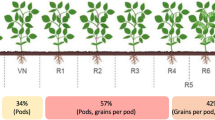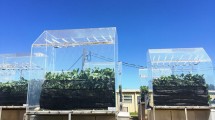Abstract
Furrow irrigating soybean prior to a large, unexpected rainfall event can reduce nitrogen fixation and crop yield. The objective of this study was to evaluate the tolerance of soybean cultivars to waterlogged alluvial soils. Five cultivars were selected, which showed a range of tolerances to excessive soil water. Flood duration and flood timing experiments were conducted on clay and silt loam soils. Main plots were flooding duration and flood timing and subplots were soybean cultivars. Most cultivars were able to withstand flooding for 48–96 h without crop injury. Cultivars flooded during the V5 growth stage suffered the least amount of yield loss. The greatest yield losses from flooding occurred at the R5 growth stage. Soybean yields from cultivars flooded at R5 were reduced by 20–39% compared to non-flooded checks. Pioneer 94B73 (cv.) had no significant change in yield from flooding for 192 h at any of the three growth stages, compared to non-flooded controls.




Similar content being viewed by others
References
Bacanamwo M, Purcell L (1999) Soybean root morphological and anatomical traits associated with acclimation to flooding. Crop Sci 39:143–149
Fehr WR, Caviness CE, Burmood DT, Pennington JS (1971) Stage of development descriptions for soybeans, Glycine max (L.) Merrill. Crop Sci 11:929–931
Griffin JL, Habetz RJ, Regan RP (1988) Flood irrigation of soybeans in Southwest Louisiana. La Agric Experiment Stn Bull 795
Heatherly L, Pringle H (1991) Soybean cultivars’ response to flood irrigation of clay soil. Agron J 83:231–236
Jackson MB, Armstrong W (1999) Formation of aerenchyma and the processes of plant ventilation in relation to soil flooding and submergence. Plant Biol 1:274–287
Kawase M (1981) Anatomical and morphological adaptation of plants to waterlogging. Hortic Sci 16:30–34
Keeney DR, Nelson DW (1982) Nitrogen-inorganic forms: indophenol blue method. In: Page A, Miller R, Keeney D (eds) Methods of soil analysis: chemical and microbiological properties, part 2. Agronomy Monograph No. 9. American Society of Agronomy, Madison, pp 674–676
Keister DL, Rao VR (1977) Nitrogen fixation in Rhizobium japonicum x planta. In: Newton W, Postgate JR, Rodriguez-Barrucco C (eds) Recent developments in nitrogen fixation. Academic, New York, pp 419–430
Laverty JC (1963) A modified procedure for the determination of phosphorus soil extracts. Soil Sci Soc Am Proc 27:360–361
Linkemer G, Board JE, Musgrave ME (1998) Waterlogging effects on growth and yield components in late-planted soybean. Crop Sci 38:1576–1584
Mills H, Jones J (1996) Plant analysis handbook II. MicroMacro Publishing, Athens
Minchin FR, Pate JS (1975) Effects of water, aeration and salt regime on nitrogen fixation in a nodulated legume: definition of an optimum root environment. J Exp Bot 26:60–69
Nathanson K, Lawn RJ, DeJabrun PLM, Byth DE (1984) Growth, nodulation and nitrogen accumulation by soybean in saturated soil culture. Field Crops Res 8:73–92
Oosterhuis DM, Scott HD, Hampton RE, Wullschleger SD (1990) Physiological responses of two soybean [Glycine max (L.) Merr] cultivars to short-term flooding. Environ Exp Bot 30:85–92
Pettry DE, Switzer RE (1996) Sharkey soils in Mississippi. Pp1. Miss Agric For Experiment Stn Bull 1057
Purcell LC, Vories ED, Counce PA, King CA (1997) Soybean growth and yield response to saturated soil culture in a temperate environment. Field Crops Res 49:205–213
Sallam A, Scott H (1987) Effects of prolonged flooding on soybeans during early vegetative growth. Soil Sci 144:61–66
SAS Institute (1997) SAS/STAT: procedures. Release 6.12. SAS Instititute, Cary
Saxton AM (1998) A macro for converting mean separation output to letter groupings in PROC MIXED. Paper 230 In: Proceedings of 23rd Annual SAS Users Group Int Conf ISBN 1-58025-149-8. SAS Institute, Cary, pp 1243–1246
Shannon JG, Stevens WE, Wiebold WJ, McGraw RL, Sleper DA (2005) Breeding soybeans for improved tolerance to flooding. Proceedings of 35th Soybean Seed Research Conference American Seed Trade Association, Chicago
Shimamura S, Mochizuki T, Nada Y, Fukuyama M (2003) Formation and function of secondary aerenchyma in hypocotyl, roots and nodules of soybean (Glycine max) under flooded conditions. Plant Soil 251:351–359
Soil Survey Staff (1971) Soil Survey of Pemiscot County, Missouri. USDA-SCS. U.S. Government Printing Office, Washington
Sprent JI (1969) Prolonged reduction of acetylene by detached soybean nodules. Planta 88:372–375
Stanley CD, Kaspar TC, Taylor HM (1980) Soybean top and root response to temporary water tables imposed at three different stages of growth. Agron J 72:341–346
Sullivan M, VanToai T, Fausey N, Beuerlein J, Parkinson R, Soboyejo A (2001) Evaluating on-farm flooding impacts on soybean. Crop Sci 41:93–100
Thomas G (1982) Exchangeable cations. In: Page A, Miller R, Keeney D (eds) Methods of soil analysis: chemical and microbiological properties, part 2. Agronomy Monograph No 9. American Society of Agronomy, Madison, pp 160–161
Thomas AL, Guerreiro SM, Sodek L (2005) Aerenchyma formation and recovery from hypoxia of the flooded root system of nodulated soybean. Ann Bot 96:1191–1198
VanToai T, Beuerlein JE, Schmitthenner AF, St Martin SK (1994) Genetic variability for flooding tolerance in soybeans. Crop Sci 34:1112–1115
VanToai T, St Martin S, Chase K, Boru G, Schnipke V, Schmitthenner A, Lark K (2001) Identification of a QTL associated with tolerance of soybean to soil waterlogging. Crop Sci 41:1247–1252
Weisz PR, Sinclair TR (1987) Regulation of soybean nitrogen fixation in response to rhizosphere oxygen. II. Quantification of nodule gas permeability. Plant Physiol 84:906–910
Author information
Authors and Affiliations
Corresponding author
Additional information
Communicated by E. Fereres.
Rights and permissions
About this article
Cite this article
Rhine, M.D., Stevens, G., Shannon, G. et al. Yield and nutritional responses to waterlogging of soybean cultivars. Irrig Sci 28, 135–142 (2010). https://doi.org/10.1007/s00271-009-0168-x
Received:
Accepted:
Published:
Issue Date:
DOI: https://doi.org/10.1007/s00271-009-0168-x




